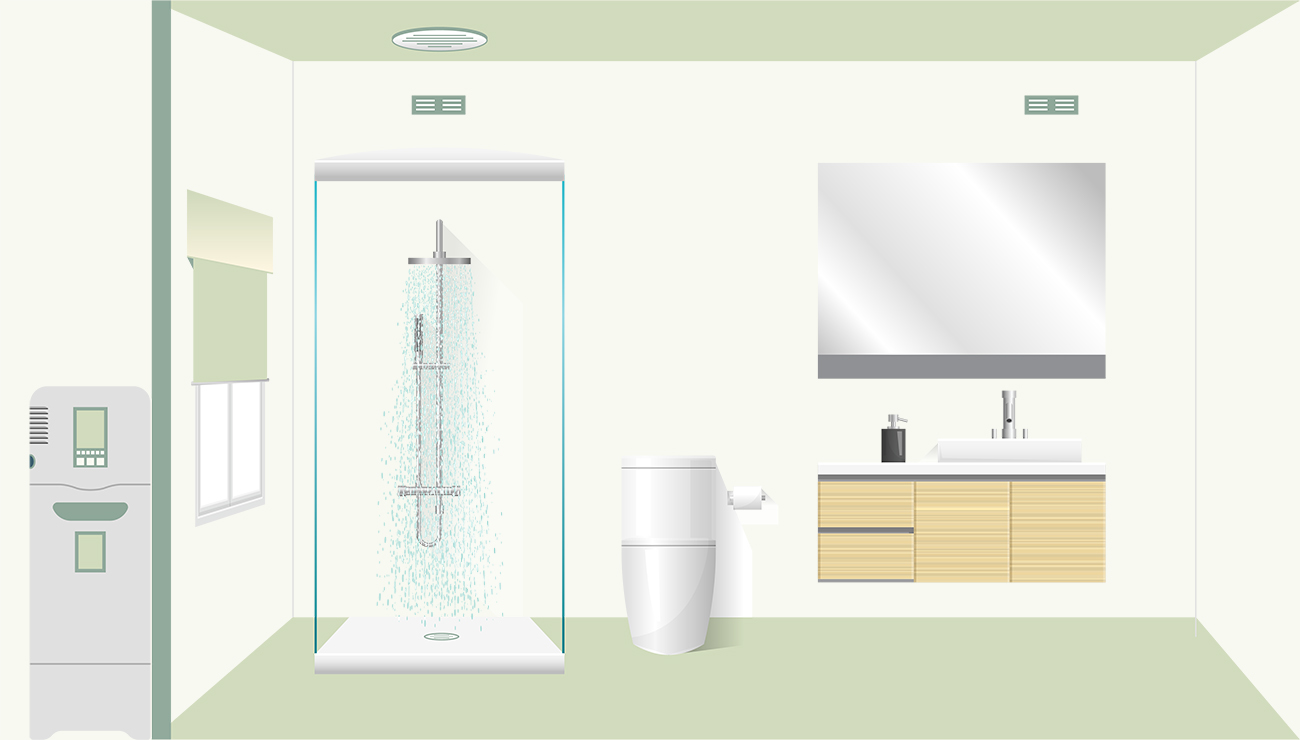Hot Water

 Heat Pump Hot Water
Heat Pump Hot Water Heat pump hot water systems
The most energy efficient way to heat water for your home is with a heat pump hot water system. These result in 60-75% less energy consumption than a traditional electric resistive hot water system. Combined with a Solar PV system they can lower your water heating costs substantially.
 Hot Water System placement
Hot Water System placement Hot water system location
The closer your hot water system is to your primary wet areas (bathrooms, kitchen, laundry), the less water will be wasted during the time it takes for the water to reach its destination. Therefore, if you are building a new home or renovating, consider locating these areas close together and installing your hot water system as close as possible.
 Insulation
Insulation Insulating your hot water system
Insulating the pipes, the pressure and temperature relief valve, and the cylinder minimises energy loss and can save you costs in the long run.
 Water saving shower heads
Water saving shower heads Water saving shower heads
Water saving shower heads may not be the first thing that comes to mind when talking about saving energy, but reducing the amount of hot water used in your shower will have a big effect on your energy bills.
Water usage isn’t always the first thing that comes to mind when considering an energy efficient home. However, in an average Australian household, around one quarter of energy used is solely for heating water. More than half of this usage is directed to the bathroom, around a third to the laundry, and the rest to the kitchen. There are a number of ways to significantly reduce this energy use in your home.
Heat pump hot water systems
The most energy efficient way to heat water for your home or business is with a heat pump hot water system. Heat pumps employ the same technology as your fridge or reverse cycle AC, using a refrigerant to absorb heat from the outside air and through a process of compression and expansion, are able to produce heat very efficiently.
For one unit of electrical energy, four or five units of heat energy can be produced, resulting in 60-75% less energy consumption than a traditional electric resistive hot water system. Additionally, Small-Scale Technology Certificates (STCs) are part of a Federal Government rebate scheme offered Australia-wide on the purchase of renewable energy technologies, which includes heat pump hot water systems. There are additional Victorian state government rebates available for installing these systems as well.
Heat pump hot water systems work well with Solar PV and offer a way of storing renewable energy (a thermal battery) for use that night or the next morning.
Upgrading to a heat pump hot water system
The good news is, whether you currently have a gas or electric hot water system, upgrading to a heat pump hot water system is possible. The switch from an electric storage system to a heat pump system takes roughly two to three hours - provided no new pipework is required. If you are making the switch from gas (highly recommended!), the process may take a little longer, as you will need to cap the gas pipe and run power to the system. Either way, it’s a relatively simple upgrade for a qualified tradesperson(s), also providing an opportunity to insulate the pipework.
When choosing a heat pump hot water system, you may want to consider a model that has an integrated timer, or check with your plumber if a timer can be fitted separately so that the heat pump can run while your solar panels produce the most electricity. Noise levels also vary between models so consider this if you are installing the heat pump near bedrooms or sensitive neighbours.
Solar thermal hot water
If you have an abundance of roof space, you may consider installing a solar hot water system. These live on the roof of the home and rely on the sun to heat your water, typically employing a gas or electric booster for those less-than-sunny days.
In Victoria however, due to our cool climate the booster will end up doing most of the work so if you are considering a solar thermal hot water system, make sure it has an electric booster, not gas. However, given the advancements in heat pump technology, and the ever-declining cost of solar, many people advise covering all available roof space with solar PV and adding a highly efficient heat pump hot water system.
Electric resistive heating
Electric Resistive Heating is available as either an instantaneous version or with a storage tank. It is not as efficient as a heat pump hot water system, but it is cheaper to install and can work well in conjunction with Solar PV if there is no suitable location for a heat pump hot water system available.
However, for instantaneous (tankless) electric resistive water heaters, three-phase power is necessary to provide enough electricity for a hot shower on the coldest days, and in contrast to heat pump hot water systems, no rebates are available for these systems in Victoria.
Hot water system location
It stands to reason that, the closer your hot water system is to your primary wet areas (bathrooms, kitchen, laundry), the less water will be wasted during the time it takes for the water to reach its destination. Therefore, if you are building a new home, consider locating these areas close together. If you are simply replacing a hot water system in an existing home, it’s possible to install the new system in a more convenient location (although beware the added expense of additional pipework).
Insulating hot water systems
Depending on your climate zone and hot water system, uninsulated hot water pipes can lose up to 3kWh/day, meaning you’ll be paying several hundred dollars more on your energy bills each year. Sustainable Living Tasmania explains how to insulate the three main components of the system - the pipes, the pressure and temperature relief valve, and the cylinder.
Water saving shower heads
We know that heating water accounts for roughly a quarter of the average Australian home’s energy usage, and that over half of that hot water is used in the bathroom. So it comes as no surprise that reducing the amount of hot water used in showers can have a huge flow-on (get it?) effect on your energy bills.
Any shower head with a flow rate of over 9L/minute or below 3 stars is considered inefficient in Victoria. You can easily measure your flow rate by grabbing a bucket and turning your shower on for 60 seconds, then measuring the amount of water collected.
Water saving shower heads are included in the Victorian Energy Upgrades program and can be replaced for little to no cost. Alternatively, if you’re not interested in participating in the program, water saving shower heads are available for reasonable prices at your local hardware store and can be easily installed yourself.
For a lower-cost solution to obtaining a lower shower flow, consider purchasing a flow restrictor, also known as a water saving disc. These are used in spouts and other connections to reduce the water flow through the shower.
